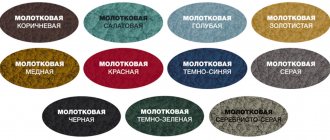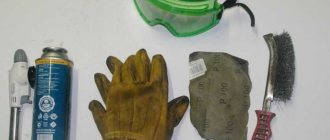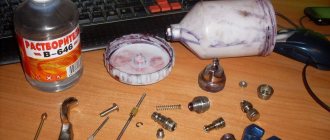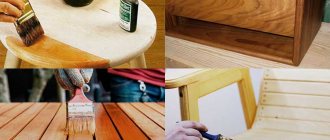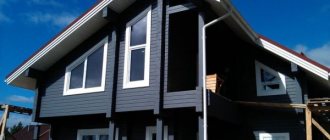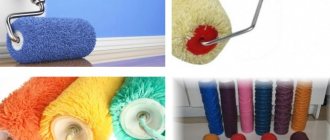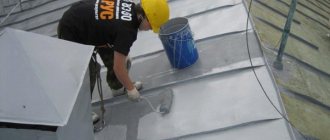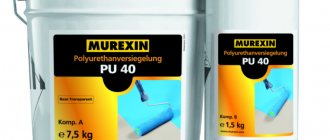Beautiful unique hammer painting, which gives the effect of frost on glass, has been known since the times of the USSR. Once upon a time, machines, hammers and photographic enlargers were painted with it, and in such a way that it was very difficult to remove the enamel. After all, hammer paint is one of the most resistant to impacts and weathering, and therefore it is increasingly being used to paint car bodies today – both beautifully and durable. And the best part is that in many cases it can be applied directly to the rust, without any primer; it also perfectly hides any defects in the putty and metal.
Hammer paint got its name because the surface painted with it is visually similar to the surface of a hammer head - the same metallic textured sheen and barely perceptible roughness. Sometimes such enamel is also called “forge”, because it is often used for artistic forging products. It is made on acrylic, alkyd-styrene and epoxy bases. Its fillers are non-corrosive aluminum “powder” and fine glass, in general, everything that enhances adhesion to metal and gives the paint special strength.
The color palette of hammer paint is quite extensive; there are even copper and gold paints.
Types of hammer paints
The most popular brands of blacksmith paints:
- ML-165 is an alkyd-styrene-based enamel, characterized by high heat resistance (up to +130°C) and adhesion. Dissolves in xylene. Can be applied to any surface.
- EP-1323 ME – epoxy enamel 2 in 1 (paint and primer), often used for painting truck cranes, cars, forklifts, fences, gates, doors. Apply to rust. Solvents – 648, 667.
- NTs-221 is a “budget” hammer nitro enamel of a more decorative rather than protective nature. It cannot be applied to rust, and in terms of heat resistance it is no better than ordinary enamel. Suitable for indoor and outdoor use.
- Hammerite is an expensive 2 in 1 hammer enamel made in England. The most popular of imported blacksmith's paints. Apply directly to rust.
Hammer paint from the English manufacturer - Hammerite
Note!
Regardless of the brand and manufacturer, hammer paint can be sold in cans and spray cans.
Kinds
Among the types, three main products can be distinguished, which are currently most in demand among consumers:
- ML – 165 is based on alkyd-styrene material, it has a high degree of heat resistance and good adhesion, and is applicable for all types of materials. The solvent chosen is xylene;
It has a high degree of heat resistance and good adhesion. - NTs - 221 nitro enamel, more suitable as a finishing decorative coating, the protective functions are low, the price is low. If a rusty surface is being processed, then thorough preliminary cleaning is required. Not highly resistant to temperature. It is used for processing objects outside and inside the building; It is used for processing objects outside and inside the building.
- Hammerite has a high cost, but the best quality. The application is made on rust, no lengthy surface preparation is required, the paint is 3 in 1. In addition to the coloring composition, it includes a rust converter and a primer. Hammerite has a high cost, but the best quality.
The main advantages and disadvantages of hammer paint for metal
The main advantages of blacksmith paint include:
- effective leveling of the base. Even if there are minor defects on the surface, a layer of enamel will smooth them out;
- ensuring corrosion resistance. If the application rules are followed, corrosion protection will be provided for an average of 8 years;
- resistance to high temperatures. Many coatings are able to retain their properties at 80°C;
- quick drying. It takes about 2 hours for the coating applied by the aerosol method to polymerize;
- high strength. High-quality coating is not afraid of mechanical stress and vibration;
- Before applying hammer paint, you can dispense with special preparation of the base. It is only necessary to remove the previously formed loose rust.
Among the disadvantages it should be noted:
- low elasticity. This makes it difficult to apply the coating to substrates with bends and dents due to the high risk of microcracks;
- poor compatibility with coatings that have a different base, which sometimes narrows the scope of application.
How to profitably exchange a used car
To guarantee the legality of the used car exchange service and its objective cost, the purchase and sale process should be carried out at a trusted auto center. Here the client will be offered:
- Diagnostics of the old model, on the basis of which its cost will be determined;
- Selection of cars for exchange, completely new or with a clean mileage history: all cars undergo forensic examination, therefore the car dealership will never sell a car with a “dark past”;
- Legal support of the transaction: the client enters into a notarized agreement and, if necessary, can use the credit services of the car dealership’s partner bank;
- Efficiency of the service: the client does not need to look for buyers for his vehicle; he does not need to settle issues with the traffic police or the bank. The listed functions are the task of the auto center.
Read here! Straightening without painting
Thus, with minimal documents, it is possible to buy an improved car within one to three days. The used car exchange service makes it possible to regularly change the owner’s vehicle fleet by purchasing its best models.
Painting rusty surfaces with Hamerite metal paint
You should not take literally the information that Hamerite paint fits perfectly on corroded metal. This is indeed true, but the rust should not fall off in pieces at the time of painting. No coating will adhere to a loose rusty substance; it must be cleaned off with a wire brush; you can also use a scraper or sandpaper with large abrasive grains. Some people advise that after finishing the procedure, wash the surface with detergents, then rinse with water, dry and start painting. Not the best way, for final cleaning of the surface you should use Hammerite Brush Cleaner & Thinners - it is intended for this purpose (also for thinning paint), and there is no need to reinvent the square wheel.
If the metal is “eaten through” by corrosion, no amount of paint will help. But a heavily rusted surface, if it has not yet entered the “sieve” stage, can be saved. To do this, perform all of the above steps and additionally treat the metal structure with Hammerite No. 1 Rust-Beater primer. That's it, you can start painting.
Interaction of Hammerite enamel with smooth metal
Steel, galvanized iron, aluminum, and other smooth metals must be sanded to achieve a rough finish before painting. Otherwise, Hammerite enamel will not adhere well to the surface and streaks will form. For greater effect and a complete guarantee of perfect smoothness, it is worth using Special Metals Primer. After it has dried, you can, with a clear conscience, start finishing the object. If you neglect the preparation steps, the paint on smooth metal will certainly peel off or begin to peel.
Advantages of painting with hammer effect
Hammer enamel is particularly resistant to atmospheric moisture, vibration and temperature fluctuations. That is why it is so actively used for painting electrical appliances, metal surfaces of industrial equipment, elements of household and building metal structures, and more. It is this paint that is most often used to create durable anti-corrosion protective coatings, not only for galvanized and steel surfaces, but also for non-ferrous metals.
Once upon a time, only cast iron and forged products were painted with hammer paint, and in such a way that it was almost impossible to remove the old layer later
And over time, manufacturers of paint and varnish coatings for cars also paid attention to the super-simple paint. They added special ingredients and hammer paint also became an excellent corrosion protection
Not only can it be applied directly to rust-damaged areas without prior repair, but it itself serves as a reliable airtight film with special binders.
At one time, manufacturers could not adapt hammer paint to color pigments - only gray was used. But today you can already get green, blue, gold, silver and even white colors. Typically, dark blue and dark green colors are used to paint a car, but those who are trying to achieve exclusivity achieve more interesting results with the help of solvents and varnishes.
Modern types of hammer paint
You can buy hammer paint today at any large construction supermarket. Often it comes complete with varnish, and looks much more impressive under it. When applying a layer of hammer paint to the car body, you should get a light shagreen texture.
So, today, among hammer paints for cars, the English “Hammerite” is especially popular. It is the most expensive, but is rightfully considered the best. Its only drawback is the difficulty of applying it on a vertical surface.
There are, however, domestic versions of hammer enamel: it covers well, dries almost on the fly, looks semi-matte and has a “weeping” structure, like frost on glass. The only thing is that in order to achieve a beautiful design, you need to paint with a velor roller - you can’t achieve such “charm” with a gun. Although a good effect can be achieved if you apply three or four layers with a spray gun.
When working with Hammerite paint, it is also important not to forget about personal protective equipment and adhere to the manufacturer’s recommendations, namely: do not paint in the rain when the air is humid (otherwise the paint will come out in pimples that will eventually burst), dilute, as a last resort, only Hammerite Brush Cleaner & Thinners, which, by the way, can also serve as a tool cleaner. You can only use a short-haired roller, but you should spray the aerosol in 4 layers, and not 2-3, like with a brush
Moreover, before use, you need to shake the can for 3 minutes and apply a thin layer from a distance of 20 cm
You can only use a short-haired roller, but you should spray the aerosol in 4 layers, and not 2-3, like with a brush. Moreover, before use, you need to shake the can for 3 minutes and apply a thin layer from a distance of 20 cm.
But the Soviet ones are most often used:
Hammer enamel ML-165 - it is used to paint car bodies and metal products that are exposed to atmospheric conditions. This paint is based on alkyd-styrene enamel. It has good heat resistance and does not change its properties even at a temperature of 130 degrees. The only thing is that before applying it, the surface should be primed and the solvent used is xylene.
Hammer paint EP-1323 ME is an epoxy enamel with a pronounced hammer effect, which contains a primer-enamel composition for rust. It is used to paint not only cars, but even cast iron products. It can be applied directly to clean metal, to scale and to rust. This, of course, does not mean that the surface can generally crumble due to corrosion. The basis of this enamel is epoxy, which forms a resistant and especially durable coating with an anti-corrosion effect. Solvents can be used No. 648 and No. 667.
Hammer enamel NTs-221 from the group of nitro enamels NTs. It is even used indoors. This enamel should be applied to a primed surface by spraying. But this particular enamel practically does not have anti-corrosion properties and the famous heat resistance, but it costs much less than other options. The basis of this paint is a solution of colloxylin with nitrocellulose and aluminum powder. Solvent can be used under number 646.
Features of hammer paint
The advantages of enamel include:
- higher level of protection from ultraviolet radiation, precipitation, salt;
- good elasticity;
- ideal masking of surface irregularities;
- original structural drawing;
- high adhesive properties;
- fast natural drying;
- smooth coating on any surface;
- breathability
- low price.
Hammer effect paint is made on the basis of alkyds and styrenes, which ensure rapid drying of the enamel. The hammer effect is achieved by diluting it with aluminum powder.
When enamel was first produced, its use was limited to factory equipment. Forged products, boilers and other working tools were painted. The paint was highly resistant to various mechanical movements, including vibrations and temperature changes.
After some time, hammer enamel became of interest to automobile companies and car service owners. After conducting several experiments mixing an alkyd-styrene base and other ingredients, they came up with a new type of paint that applies easily to any surface and is also resistant to corrosion and impact. The shades of paint also did not turn out right away. Initially, a gray metallic color was used, and only then the range expanded.
The disadvantages of hammer paint include its instability to brake fluid and poor adhesion to acrylic primer.
Hammer enamel painting technology
The application of hammer enamel is somewhat different from standard paint and varnish coatings. The temperature at which painting will be carried out should not be aggressive: not lower than -10 and not higher than 30 degrees Celsius.
How to paint with hammer paint?
A special feature of this type of painting is the absence of putty and priming steps, because all these functions are performed by hammer paint for metal. Any irregularities and minor scratches are masked with several layers of enamel.
If the hammer paint already contains a solvent, there is no need to dilute it with other means. Experts recommend painting metal structures using a roller, but a spray gun is also suitable, although it will not create the desired structure. Painting with a roller takes place in 2 stages with breaks of 30 minutes, with a puller - 4 layers with 20-minute pauses.
Stages of painting with hammer enamel
To paint a car you will need the following:
- hammer paint for metal;
- short-haired roller or spray gun;
- solvent 647;
- primer-enamel;
- abrasive paper.
All ingredients must be prepared in advance and always on hand:
- First of all, the car needs to be cleaned and degreased. Additionally, you can use abrasive or sandpaper to make the surface slightly rougher for better paint adherence.
- If there are large rust spots on the car, they need to be treated with a rust converter, but if there are minor flaws, this step can be skipped. Hammerite hammer paint contains components that coat corrosive areas and prevent them from spreading, therefore, using such enamel, you can reduce the time it takes to remove rust.
- The elements to be painted must be treated with a highly diluted rust enamel primer.
- After cleaning the surface of the product, you can apply hammer paint. It is not advisable to dilute it with other solutions to avoid disturbing the proportions of the ingredients. Application is carried out using a roller (a brush uses up too much paint). The surface of the car should be matte, since enamel does not take on a glossy finish. To give the desired texture, the metal should be sanded. After the first coat, you need to wait 30 minutes and then apply another one. The paint will dry completely in 6-7 hours at room temperature, but it is advisable to put the car into operation after 2-3 days.
Main features of coating application
The most common technology for high-quality painting of products with the described hammer paint is similar to the process of applying paints of other brands, with the exception of some differences. The painting process is carried out using the most common tools that are usually used when working with other paints.
You will need materials and equipment such as:
- Spray gun;
- Brush;
- Roller made on a velor base;
- Directly the paint itself;
- Solvent 647;
- Primer-enamel;
- High quality abrasive paper.
A roller and a brush are necessary for the reason that it will be much more convenient to paint some elements of the car with just such tools in order to obtain the desired result. A roller and brush will help to achieve some relief in the coating. Also, their use will provide a slight metallic sheen with an attractive drizzle effect.
How to determine whether the muffler is faulty on a Lada Kalina
Domestic cars have a simplified exhaust system design. Thanks to this, the driver can easily determine malfunctions in the operation of the Lada Kalina muffler.
First of all, it is necessary to clarify exactly what risks are possible when using a faulty device:
- If a hole has formed in the plug, toxic gases can enter the cabin. The danger is that the exhaust gases are colorless and odorless. After even a short period of inhalation, the driver may feel headache, nausea and fatigue;
- If the system mechanism fails, loud popping noises in the resonator will immediately be noticeable. And today, many city districts and entertainment establishments limit the noise level on their territory, so the driver of a car can receive a fine;
- decreased comfort while traveling, since the noise level with a faulty muffler will not allow you to talk or listen to music.
Malfunctions can be determined independently. This does not require any special knowledge or equipment.
It is important that the muffler is always in a strictly horizontal position
Step-by-step instructions for diagnosing a malfunction
Proceed in the following order:
- Listen carefully to the noises that arise when the car is moving. If the muffler is faulty, the car will run much louder than before. And also knocking or a characteristic gurgling sound while driving indicates a breakdown in the exhaust system.
- Raise the car on a jack and inspect the body of the device. There should be no holes or even ordinary rust on it. If there are already rust marks on the case, then most likely there are also some defects inside the case.
- When driving, carefully monitor the quality of the exhaust gases. If black and dense smoke periodically escapes from the muffler, then there is definitely something wrong with the exhaust system.
- Start the engine and rev it up for a few minutes. Then turn off the ignition and check the engine temperature. After a short period of operation, the motor should not have time to heat up. If there is overheating, it means that the mechanism is not doing its job.
Main malfunctions in the muffler
And also the following factors can be attributed to malfunctions:
- mechanical damage while driving or parking;
- severe corrosion, as a result of which holes form on the muffler or resonator housing;
- burning out of small elements, due to which the entire system loses its tightness.
Main features of Hammerite paint and its varieties
Metal is susceptible to corrosion, everyone knows this. How long the car body can withstand an aggressive environment depends on the quality of the paintwork. None of the compounds provides a 100% guarantee of protection.
Any paintwork fades and fades over time, the enamel begins to crack and peel, and pockets of corrosion appear.
Therefore, it is especially important to choose a composition that provides long-term, reliable coverage. It is Hammerite paint that can protect metal from many problems, since innovative technologies and components are used in its production
The main feature of this coating is that there is no need for mechanical preparation of the surface before its application. This significantly reduces processing time. Hammerite paint is applied directly to areas of corrosion thanks to its innovative composition, which includes the following main components:
- modified synthetic alkyd resin;
- anti-corrosion additives;
- technical wax;
- fast evaporating solvent;
- color pigments;
- active additives.
Each component of the paint and varnish mixture has its own purpose, and thanks to their combined action, the painted car body will become immune to rust. Hamerite enamel can create a paint layer with various effects on the metal surface being processed. It happens:
- hammer;
- smooth.
In turn, smooth enamel can have a semi-matte or glossy texture. Hammerite paints can be used both for metal work and for painting a wide variety of surfaces. The color range of this brand of coatings is very diverse, which allows it to be used in various areas.
Painting wheel rims with a brush.
My cast standard “Kalinovskie” wheels broke... But I also have a “winter” set, which my colleague sold at an attractive price last winter.
The appearance of the “winter” rims put me in cognitive dissonance...it’s a bit of a hassle to drive, and it’s a shame... As a result of hard googling, it was found out that in St. Petersburg they would paint my rims for 5,000 rubles. Toads. Therefore, the decision was made to paint them myself.
A plan was developed, which was followed throughout the entire work:
1. Wash the wheels. The Internet recommends dragging them into a bathtub and scrubbing them with special chemicals until they turn blue. No, it’s very lazy and there’s no bath. We wipe it bluntly with a wet cloth, simultaneously dipping it in a bucket of water.
2. Sand the wheels. It is necessary to remove everything that is peeling off, peeling and oxidizing. I decided to treat this stage more responsibly than the first, since all the jambs will be visible during subsequent painting. We sand it with sandpaper No. 80, and finish it with 120 sandpaper on a paralon base.
Quite normal, you can paint it.
3. Paint. There are 2 options, either with a spray can or with a brush. It’s cool from a spray can, but not at home, plus the price is 250 rubles. per cylinder. And then the Internet gave me information about Hammerite paint.
Quote: “Unlike traditional metal coatings, Hammerite is applied directly to rust-pigmented surfaces. Thanks to the 3 in 1 formula, no primer or undercoat is required. Hammerite's short drying time means the job can be completed in a matter of hours, compared to several days with traditional flooring. In addition, the Hammerite coating can easily withstand rain within 1 hour after application, and special silicone additives provide a reliable barrier to moisture penetration and, thus, long-term protection of the metal from corrosion.”
Trusting the Internet, I bought a can of paint and a brush. Let's paint.
This is mega paint. In everything.
Finished discs to dry.
Bottom line. Who doesn't have an extra 5,000 rubles. for painting, feel free to paint with a brush. A can of paint costs 500 rubles, of which I only spent a third for 2 layers on 4 discs. You can paint it at home because it doesn’t stink and dries quickly.
Acrylic and water-based paints are widely known to consumers. Many people are experienced enough to use them without paying much attention to the manufacturers' instructions. But the same cannot be said about hammer paint, although its merits are not in doubt. In some cases it is necessary to use only this coating.
Coloring Tips
If the paint mixture is too thick, you can dilute it, use a solvent, for example, Nitro 645, 646. If you dilute the composition with this solvent, it will not have any effect on the quality of the painted layer or its glossy shine
Before you start painting, it is important to mix the coloring solution thoroughly so that it has a homogeneous structure and uniform consistency.
Many people ask how to paint with hammer paint? For painting, use a brush, roller, or spray gun. In addition, the coloring solution is sold in aerosol cans. Thanks to the use of a spray can, you can easily and quickly paint uneven and hard-to-reach areas
When applying hammer paint to metal with a spray can, roller or brush, it is important to ensure that the layer is not very thick, so that there are no sagging or drips. The thickness of 1 layer should be about 100 microns
This layer is sufficient for high-quality and durable protection of wood or metal. If you need to paint a small area, it is best to purchase the composition in a spray can.
When using an aerosol can, it must be shaken sharply several times. It is very difficult to determine how much mixture is left in the can, so it is best to apply a thin layer and wait about 20-30 minutes for it to dry before applying a second coat. The material consumption when using a can can be roughly determined by its weight; when the amount of paint in the can decreases, it becomes lighter.
If you need to paint a large, extensive surface, it is better to use a spray bottle. When using it, it is necessary to dilute the hammer paint so that it is liquid. A solvent is used as a diluent; it must be mixed with the coloring mixture in a ratio of 2 to 1. This proportion is optimal when painting at room temperature. And if the temperature is significantly lower, then the proportion must be adjusted. When painting automobile parts, to protect them from corrosion and rust, the paint is diluted with a solvent in a ratio of 9 to 1. The spray bottle must be held to the surface at an angle of 90 degrees.
When painting with any tool, it is important to use personal protective equipment such as a respirator, rubber gloves and goggles. Professional experts recommend adhering to the following rules when painting:
when painting with a roller, it is better not to dip it into the paint mixture, but to pour a small amount of paint onto it, and then roll it out; You should not use a foam rubber coat for the roller, as the coloring composition will destroy the foam material; the second coating cannot be applied until the first layer of dye has dried; It is better to use a brush for those materials that have a broken, complex surface
When using a brush to paint smooth surfaces, there will certainly be gaps, streaks and streaks; It is advisable to apply more paint to welding areas and joints than to other surfaces, since these areas are the most vulnerable; To ensure that there are no streaks after painting, it is best to paint the entire area at one time; when painting, you should not rush to apply the mixture; it is important to work slowly, even if you need to process a small part; It is necessary to paint with a small amount of hammer paint so that there is no too thick layer and sagging. You should not rush to start using the painted surface. Although the dye sets in a couple of hours, it finally dries only after two weeks; to achieve the best effect, it is recommended to apply the coloring solution not in 1, but in several layers, maximum 5
After each staining, it is important to wait 6-8 hours; before painting, it is best to treat the metal with a solvent from the same manufacturer as the paint; when painting outside, the weather should not be rainy or damp, it is recommended that it be sunny and dry; The best temperature range for painting is from +8 to +25 degrees.
So, despite the rather high cost, hammer paints are very popular today. You can buy this composition in almost any paint and varnish store. After painting, an attractive and durable coating is formed on metal or wood, which is characterized by a long service life, high resistance to mechanical stress and atmospheric conditions.
Peculiarities
Hammer paint is intended for painting rusty surfaces. The presence or absence of an original layer of other paint, as well as the execution of external or internal work, does not matter. In all cases, the coloring composition manifests itself with dignity and quality. It acquired its name from the appearance of the applied coating. It appears to be made of metal that was hand hammered with a blacksmith's hammer.
Initially, hammer paints were used to cover industrial and laboratory equipment, for which external beauty was less important than service life. Until recently, no other hammer paint colors (except gray) were produced.
It is capable of masking significant differences in the surface, and can also be used for re-painting. In recent years, technologists have corrected the shortcomings of their predecessors, and now this material is made in a variety of colors and shades.
Advice from the experts
Recommendations from the experts help to paint products with hammer dye faster and with better quality:
- When working with a roller, the tool does not sink into the mass. It is poured in small doses onto a fur roller, after which it is evenly distributed.
- A foam-coated roller is not available. The material will suffer if it comes into contact with paint.
- Each subsequent layer is applied to the dried previous one.
- For a surface of complex shape, a brush is an ideal tool; on a smooth surface, areas are often poorly painted and gaps appear.
- The coating will look evenly applied if the entire cycle of work is completed without large interruptions outside the plan.
- Welding areas and various mechanical components are carefully painted. In this case, there should be no layering of CM.
- Preparatory work on the base surface only enhances the reliability of the coating.
- The work uses solvent and paint of the same brand.
Types of hammer paint
Hammer enamel, after being applied to a metal surface, forms a coating that is resistant to aggressive environmental influences - temperature changes, mechanical damage, ultraviolet radiation. In addition, enamel with a hammer effect has anti-corrosion properties - the surface painted with it does not oxidize and does not rust even at high air humidity.
The performance properties of this composition are the reason for its widespread use in all areas of industry. In addition to painting cars, hammer enamel for metal is used for painting production equipment, fences and doors, building structures, and electrical appliances.
Types of hammer paint are classified based on the material of the binder base, to which styrene filler and aluminum powder are added (components that give the composition a hammer effect). Alkyd and epoxy resins or cellulose nitrate are used as a binder base.
The following brands of hammer compounds are used for painting cars:
- ML-165 (based on alkyd resins), is used for painting vehicles operated in harsh atmospheric conditions - SUVs, the body of which is constantly in contact with dirt and moisture. ML-165 is classified as heat-resistant paint; it retains its properties when the temperature rises to 125 degrees. This material requires preliminary priming of the surface to be painted; to prepare the working composition, a xylene-based hammer paint solvent is used.
- Rust enamel EP-1323ME (based on epoxy resin) - does not require priming of the surface to be painted (contains a one-component primer). No metal stripping is required; the composition is applied directly to oxidation and scale. The epoxy paint base prevents the further spread of corrosion and has high adhesion to the untreated surface. Polymerization of paint occurs at room temperature, its main disadvantage is the long drying time (up to 48 hours);
- Hammer effect paint NTs-221 (based on cellulose nitrate and colloxylin) is a budget composition that does not have heat resistance and anti-corrosion properties. In fact, this material has only a visual resemblance to similar compositions - when applying it, it requires cleaning the surface from rust and priming.
Choose reliable tools for painting
Along with compositions from domestic manufacturers, Hammerite paint, produced by the English company of the same name, is used. This material is more expensive than its analogues (800-900 rubles per 1 liter), however, due to the addition of silicone filler to the composition, Hamerite has better elasticity and, as a result, resistance to mechanical damage.
Hammerite anti-rust paint does not require prior priming of the surface; it is applied to oxidized metal and prevents the further spread of corrosion. Painting a car with Hammerite hammer paint is carried out in a room with low air humidity, otherwise bubbles will form on the surface, which subsequently crack, which leads to the destruction of the paintwork.
How to choose a solvent
Before thinning hammer paint, you need to select a suitable thinner. The solvent should be selected based on the manufacturer’s recommendations, which are indicated on the packaging. For conventional formulations, toluene or xylene is used.
You cannot use solvents other than those specified by the manufacturer for Hamerite paint. A special diluent has been developed for this composition, which helps improve the properties of the composition. Other products created to dilute paints may worsen the result.
The solvent should be selected based on the manufacturer’s recommendations, which are indicated on the packaging.
Features of hammer paint
The hammer effect of the paint is achieved by adding fine aluminum powder to the acrylic or epoxy base, which forms a characteristic patterned texture on the painted surface.
This class of paints and varnishes has the following operational advantages:
- Resistance to moisture and precipitation - a silicone filler is added to the composition, which ensures the hydrophobic properties of the painted surface. Expensive materials (Hammerite) contain tiny grains of glass, which further enhance the water-repellent effect;
- Due to the silicone in the composition, the dried paint is elastic, it does not crack or be damaged by mechanical stress, the surface is resistant to scratches and abrasions;
- Hammer enamel for rust is a multicomponent mixture; in addition to the basic components, it includes primer and styrene filler, which prevents further spread of rust oxides on the metal surface;
- Polymerization of compositions based on acrylic and epoxy bases (with the exception of paints based on epoxy resins) occurs in the shortest possible time - up to 30 minutes, at room temperature, which reduces the time of multi-layer painting of a car body;
- After drying, hammer paint for rust forms a protective layer that is not destroyed by splashes of auto chemicals, brake fluid, gasoline and diesel fuel;
- Painting with hammer enamel does not require “jewelry” work to prepare the car body - it is enough to remove pockets of corrosion with sandpaper, level and plaster large deformations.
Sanding a car before painting
You can paint the car body over the old paintwork, giving it a rough surface with sandpaper. Manufacturers claim that you can paint with hammer paint without prior priming, but if you are interested in obtaining a durable and high-quality coating, we recommend covering the surface with 2-3 layers of primer.
The technology of painting with hammer paint does not provide for the possibility of mixing the composition with other types of enamels. Glossy and matte materials should not be mixed with each other. When mixing paint to obtain the required shade, any colors are combined, with the exception of gold and silver.
Recommendations
A special camera will help improve the resulting effect; the process of its creation is discussed in the article - “How to make a spray booth with your own hands”? The painting algorithm is discussed in more detail in the dedicated article - “How to paint a car with your own hands”?
If the reason for painting with hammer paint is to remove scratches, there are other ways to get rid of minor damage, read – “Removing scratches on a car without painting.”
Hammer-effect enamel is often used on wheels to protect them from salt, moisture and chemicals that coat roads in winter. The paint for the wheels is selected separately from the body, taking into account the characteristics of use. Powder coating of discs is predominantly used.
